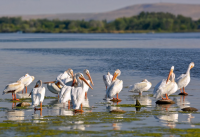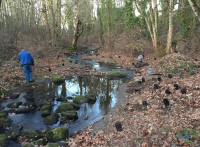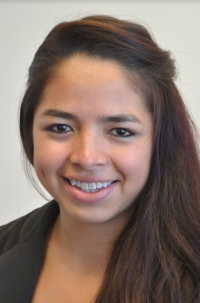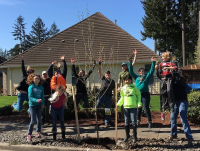We sat down with Futurewise, Watershed Alliance of SW Washington, OPAL Environmental Justice Oregon, and Lower Columbia Fish Recovery Board that received funding through Columbia Riverkeeper lawsuits to find out how penalty funds are fueling important work to protect salmon, educate the next generation of river stewards, and reduce pollution.
Stop. Deter. Right the Wrong.
How Penalties from Columbia Riverkeeper Lawsuits Restore, Protect Clean Water
Columbia Riverkeeper cracks down on illegal pollution by enforcing the Clean Water Act. Our top priority: Stop the pollution. Our second goal: Deter industry from violating the law in the first place. How? Our settlements require the offending company to pay a penalty. As part of the lawsuit settlement, the penalty funds support projects by other organizations that benefit water quality.
In the last decade, penalties from Riverkeeper’s Clean Water Act lawsuits supported dozens of important projects to protect and restore water quality. We sat down with four organizations that received funding through a Riverkeeper lawsuit to find out how penalty funds are fueling important work to protect salmon, educate the next generation of river stewards, and reduce pollution.
Alison Cable, Tri-Cities Program Manager, Futurewise

In 2017, Futurewise—a non-profit that works to prevent sprawl to protect Washington state’s resources and make our urban areas livable and available for all—received a $400,000 grant through a Columbia Riverkeeper settlement.
Why fight sprawl in the Tri-Cities?
Last year, Franklin County was the fastest-growing county in Washington state, and cities in Benton County weren’t far behind. There are lots of contributing factors—everything from good weather, job opportunities, and lower housing prices—and there is also a lot of open land, which makes it seem as if sprawling development is the answer to the region’s growth challenges. However, we know that low-density development is unsustainable economically in the region, leads to over-allocation of groundwater, and contributes to increases in surface water pollution and a loss of agricultural land, an important part of the local economy. There is also a very relevant case to be made against sprawl in light of the region’s recent challenges with poor air quality: Morecars, and an increase in frequency and length of single-occupancy vehicle trips, significantly contribute to air pollution and impact public health by exacerbating cases of asthma, heart disease and hypertension. We believe the Tri-Cities has incredible potential to be a leader in economically sustainable development patterns, and we want to see the populationand the natural systems thrive in a healthy environment.
How did funds from Riverkeeper’s Clean Water Act settlement support Futurewise’s work?
While Futurewise has worked on issues in the Tri-Cities in past years, the funding from Riverkeeper allowed us to hire local staff for the first time. For an organization like ours that is a resource for technical and policy support on complex land-use issues, having a local person in the community who can help educate and inform interested residents significantly broadens and deepens the impact of our work.
Having a local staff person also allows us to make personal connections with elected officials and other community leaders who make decisions that impact land and the environment in the Tri-Cities. While we’re most widely known as an organization that challenges local government decisions, we much prefer to work together on making proactive decisions that protect people, the environment, and the economy. Even if we never quite see eye-to-eye on every issue, having that personal connection has helped us begin to build respectful relationships with decision-makers, and is leading towards more sustainable outcomes in the long-term.
Futurewise works all over Washington state. Is it harder to fund conservation work in the Tri-Cities versus other major metro areas?
Funding the type of work we do is very difficult generally, and it’s extra difficult in the Tri-Cities, where there are few philanthropic organizations and fewer independent donors who can provide sustainable contributions. There’s a real “chicken-and-egg” syndrome where we’re unable to educate and inform potential funders and donors about our work without resources, and we’re unable to gain resources because there are so few funders and donors aware of our work. This is why the funding from Riverkeeper’s settlement was so critical—it is allowing us the opportunity to provide community education, and build a local network that hopefully will sustain our program over the longer term.
Any inspiring success stories to report?
Last year we appealed the Benton County Comprehensive Plan Update. While our advocacy work led the county to improve the comprehensive plan, important work was left undone, and so we hope to use the appeal to work with Benton County to resolve several issues related to groundwater planning, water pollution from development, and development protections from wildfires—three key rural development issues on many people’s minds in Eastern Washington.
We are excited also about the momentum surrounding the coalition we are helping to convene, For Our Rivershore. The group is advocating for more and improved public processes around potential riverfront property conveyance from federal to local hands—an issue that could have major impacts on water quality and public access to the waterfront.
Sunrise O’Mahoney, Executive Director, Watershed Alliance of SW Washington

The Watershed Alliance of SW Washington works to educate and engage community members to be active stewards of the southwest Washington area’s natural legacy, with a focus on creeks, lakes, and other water bodies.
In 2016, Columbia Riverkeeper approached the Alliance about supporting on-the-ground work to improve water quality in Vancouver. Why did you choose Fisher Creek?
In just three decades, this creek system has seen dramatic changes to water quality, flow level, and plant species. Many areas were dominated by invasive plant species. Yet the foundation of a good system was present there: water flow, many mature native trees and sporadic patches of native plants. By tackling it now, before it gets worse, we could make a significant change to the system and reduce the impacts of the surrounding development. Fisher Creek flows directly into the Columbia River. It’s a great place to increase native plant diversity, stabilize the creek banks, and educate the surrounding neighborhood.
What was the biggest challenge you had to overcome to restore Fisher Creek?
The biggest challenge was contacting the appropriate property for each homeowners association (HOA) parcel. In the end we discovered that four HOAs own the nine parcels that border this stretch of the creek. After meeting with each of them, they agreed to partner with us in this effort.
Let’s talk numbers. How many acres did you restore and how many trees did you plant?
The four HOAs border both sides of Fisher Creek for 4,283 feet, or more than eight-tenths of a mile. We sprayed more than 15 acres of blackberries and pulled 50 cubic yards of ivy. And we planted 2,805 native trees and shrubs.
Would this project have happened without funding from Columbia Riverkeeper’s Clean Water Act settlement?
No, it wouldn’t have.
Share your favorite story from the restoration project.
The first homeowners association that signed up for the project, The Lakes at Fisher’s Landing, was very eager to participate. Some of the neighbors had tried to pull weeds on their own over the years, but there was no coordinated effort. After Tom (from our staff) spoke at their neighborhood meeting, he had a list of interested neighbors who committed to be the caretakers of the site, watering the plants throughout the dry season. That kind of community partnership makes project like this a success for years to come.
Marίa Hernańdez Segoviano, Community Engagement Coordinator, OPAL Environmental Justice Oregon

Founded in 2006 by and for low-income people and people of color, OPAL Environmental Justice Oregon is the membership-driven hub at the center of our region’s movement for environmental justice.
Earlier this year, OPAL received a grant funded through a Riverkeeper Clean Water Act lawsuit. Tell us about the project.
The grant will bring together people impacted by Columbia River pollution and fossil fuels to engage a curriculum exploring environmental justice and a just transition from fossil fuels. Our goal is to uplift issues communities experience right now.
We’ve engaged individuals living near the Columbia. We use a train-the-trainer model. In one of the smaller sessions, the curriculum describes the history of environmental justice and adds concrete examples of what people are experiencing right now. We are continuously adapting the curriculum based on what people share. I recently gave the curriculum in Spanish. As a native Spanish-speaker, it was really intense and powerful.
At the end of the project, people will have direct access to share their perspectives with the Oregon Governor’s Task Force on Environmental Justice. Why the Task Force?
The Task Force provides advice to the Governor on environmental injustice issues and offers a powerful avenue for community members to raise their concerns and demand action. For example, the Task Force had a meeting in Medford and members of the Oregon Just Transition Alliance attended to talk about the (Jordan Cove) LNG pipeline. Ultimately a letter went out from Task Force to the Governor on the LNG pipeline.
What motivates you to work as the advocacy coordinator for OPAL?
I was born and raised in Mexico and experienced the global effects of environmental injustices—whether immigration, transportation, climate, or housing. I consider this job a privilege. I want to continuously remove barriers so members in our communities can engage. I’m also inspired by the youth volunteers in our office, my coworkers, partner organizations, and our members.
How can Columbia Riverkeeper members support OPAL’s work?
Go to OPAL’s website and donate. We organize people. Our movement must sustain itself—we can’t be dependent on big corporations and big foundations. We can also coordinate as partners, like Riverkeeper and OPAL’s partnership on the Portland Clean Energy Fund. Reach out to me to talk about organization partnerships—happy to chat.
Steve Manlow, Executive Director, Lower Columbia Fish Recovery Board

In 2013, Columbia Riverkeeper, the Rosemere Neighborhood Association, and the Northwest Environmental Defense Center challenged Clark County’s violation of laws designed to protect salmon and reduce pollution. After losing several rounds of litigation, the county agreed to address the problem and pay a $3 million penalty to the Lower Columbia Fish Recovery Board for projects to protect and restore rivers and streams harmed by stormwater pollution.
What is the Lower Columbia Fish Recovery Board?
The LCFRB was established by State statute in 1998 in response to the Endangered Species Act-listings of salmon and steelhead. We were the first salmon recovery region established in the state, and our primary mission is to develop and oversee implementation of a recovery plans for the ESA-listed fish. We also wear several other hats, including facilitating development of watershed management plans and managing a variety of grant programs aimed at watershed restoration and conservation.
Why invest in habitat restoration in the Lower Columbia?
The Lower Columbia has the highest number of Endangered Species Act-listed salmon and steelhead populations—74 to be exact—in Washington state. Our job is to facilitate recovery of these populations to healthy and harvestable levels. Unless we protect and restore habitat, we won’t meet our goals. In rapidly developing communities like Clark County, this includes mitigating the effects of stormwater runoff.
What types of projects did the Board fund with the $3 million Clean Water Act settlement?
The Riverkeeper settlement was the largest in our history, and to date we’ve awarded 11 grants to support a range of projects. They include a combination of water quality improvement, outreach and education projects. For example, last year we funded the “Don’t Drip and Drive” project—an innovative partnership between Clark County, Vancouver Watersheds Council, Stormwater Partners of SW WA, and the automobile industry—to reduce oil pollution. We have also funded several of the Lower Columbia Estuary Partnership’s outreach and education projects that will reach more than 2,000 students and volunteers through a combination of classroom education and hands-on restoration work. These projects are aimed at increasing the future generations’ knowledge and awareness of their watersheds, the impacts of stormwater runoff, and how their actions can improve watershed health. We are gearing up for a third year of funding right now.
What are some of the biggest barriers to habitat restoration in the Lower Columbia River?
One of the greatest challenges is protecting the habitat we have in the face of development, while trying to improve watershed conditions over the long-term. This will take a fundamental shift in how we interact with our watersheds. Education and outreach is critically important, yet chronically under-funded. This program has helped fill this gap.
What’s your favorite area in the Lower Columbia to spend a Saturday?
I really enjoy spending time in the Columbia River Gorge, specifically the Table Mountain area. It is a beautiful area that supports diverse geology and plant and animal communities.
What inspired you to leave the U.S. Army Corps of Engineers to lead the Board?
I’ve worked in the Lower Columbia region since 1991, much of that time with Washington Department of Fish and Wildlife in their habitat program. In the mid-2000s, I also spent three years working for the LCFRB on development of watershed plans. I moved on to the Corps for six years, but had the opportunity to come back to the LCFRB when the prior director, Jeff Breckel, retired. My heart has always been in conservation work, and I really appreciate the opportunity to lead the Board’s efforts.
Take a stand for clean water and healthy communities. Your membership protects and restores the mighty Columbia River now and for future generations.
Columbia Riverkeeper's River Currents newsletter showcases the effective and diverse work that you make possible.


